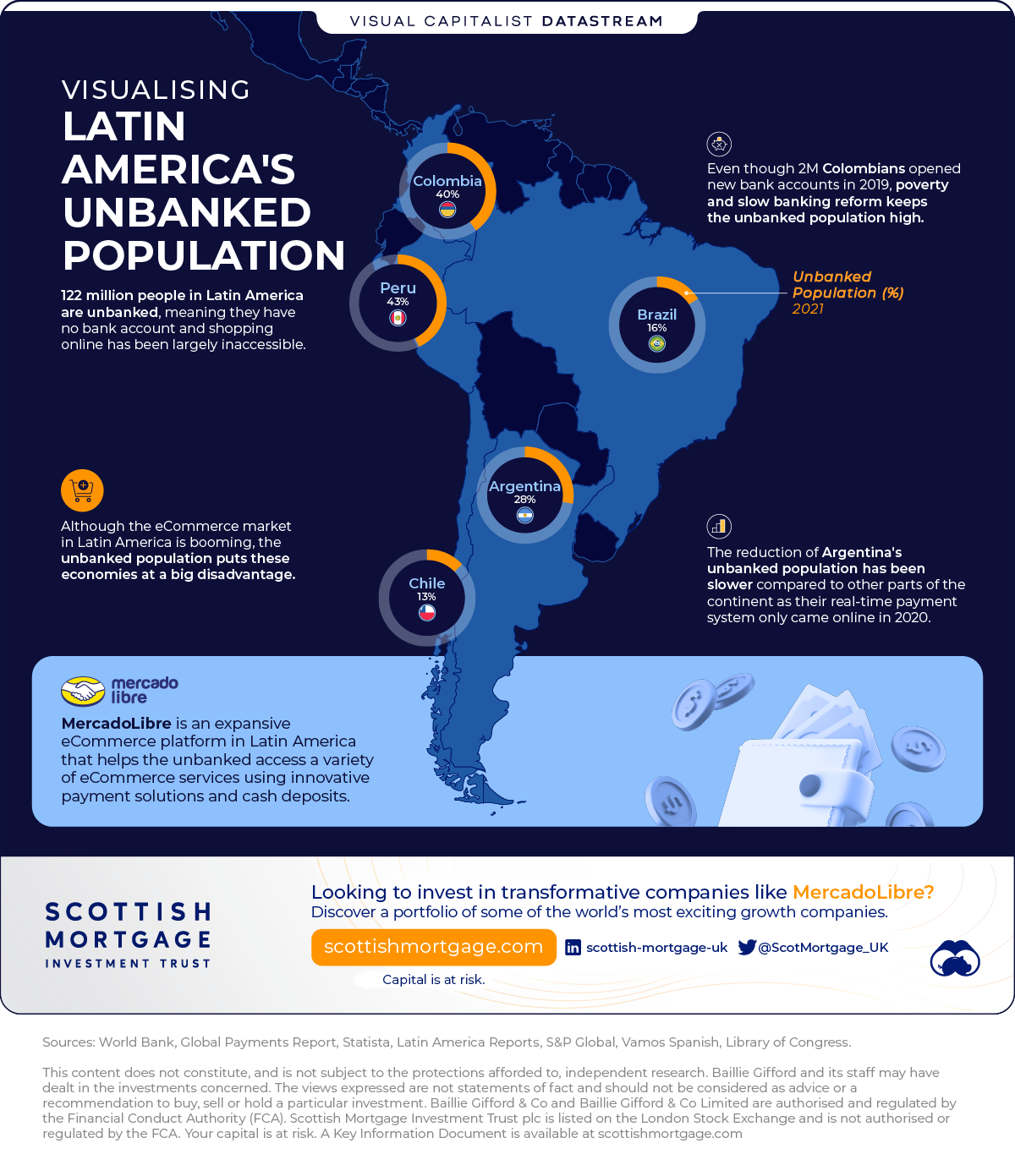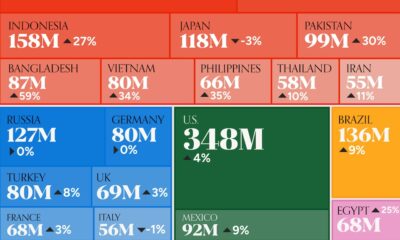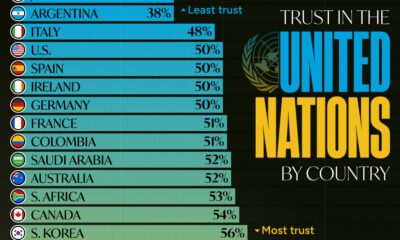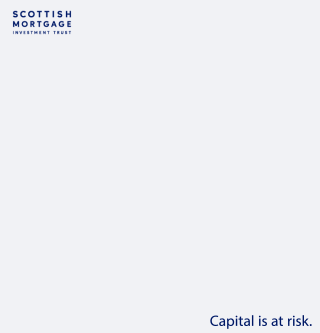Datastream
Visualised: Latin America’s Unbanked Population
The following content is sponsored by Scottish Mortgage Investment Trust
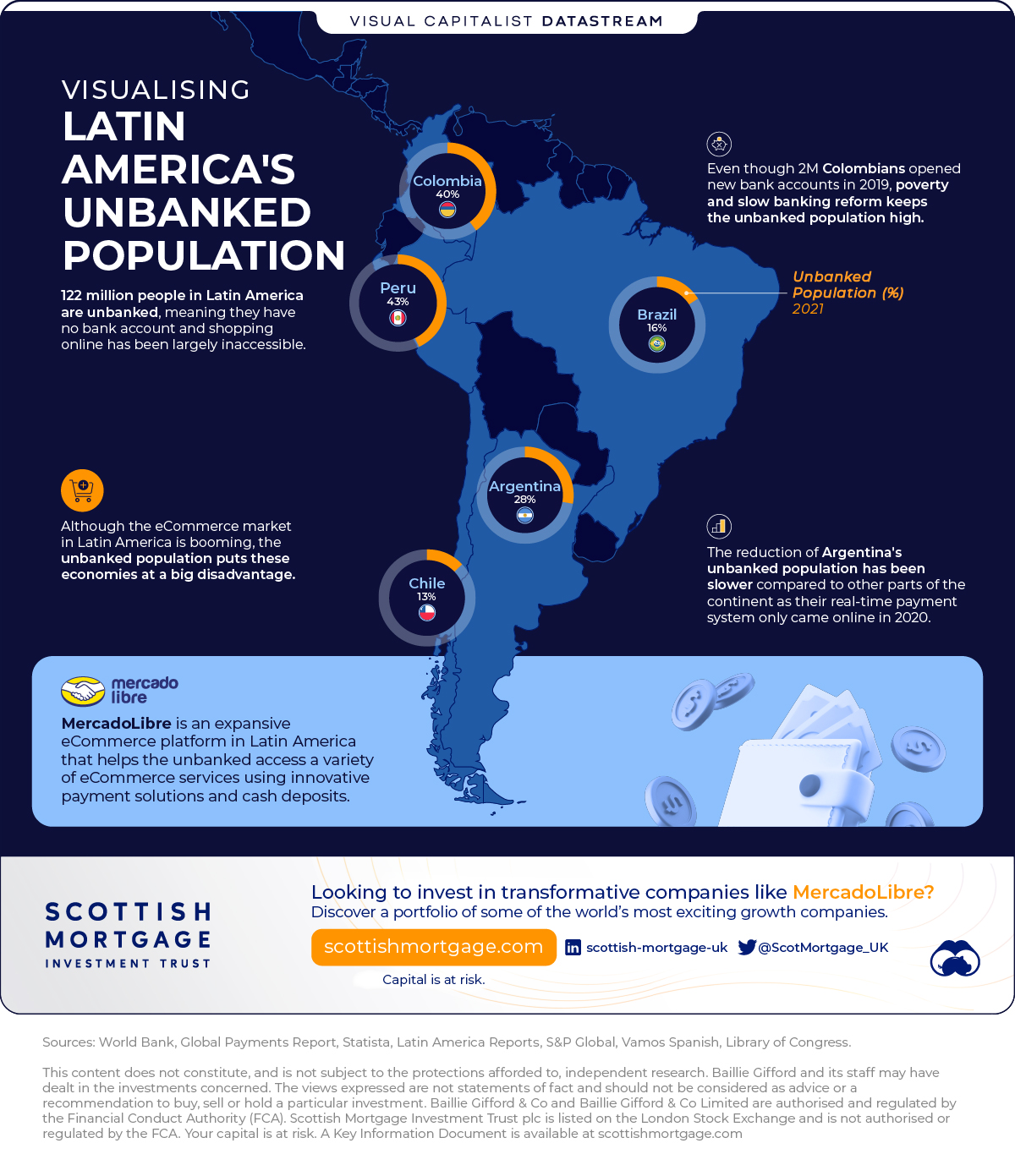
The Briefing
- According to the World Bank, 122 million people in Latin America were considered unbanked in 2021.
- Creative payment solutions such as those posed by eCommerce company MercadoLibre help these populations access digital markets.
Visualising Latin America’s Unbanked Population
Did you know that as of 2021, a staggering 1.9 billion people globally were unbanked, and 122 million of those were in Latin America?
This figure highlights the pressing need to address financial exclusion in the region, especially considering its booming eCommerce market.
In this post, sponsored by Scottish Mortgage, we shed light on the unbanked population in Latin America and examine the steps being taken to provide them with banking services.
Mapping Latin America’s Unbanked
Here’s a look at several of the largest economies in the region and their unbanked populations using the latest data from the World Bank:
| Country Name | Unbanked (%), 2021 |
|---|---|
| 🇨🇱 Chile | 13% |
| 🇧🇷 Brazil | 16% |
| 🇦🇷 Argentina | 28% |
| 🇨🇴 Colombia | 40% |
| 🇵🇪 Peru | 43% |
The number of people without access to banking services in Latin America differs by country. In Colombia, for instance, 40% of the population is unbanked. However, approximately 2 million individuals opened bank accounts in 2019, which helped contribute to a decrease in the overall unbanked population from 54% in 2017 to its current level.
The reduction of Argentina’s unbanked population has also been relatively slow compared to other parts of the continent. This can be attributed, in part, to the delayed implementation of their real-time payment system, which only came online in 2020.
Enter MercadoLibre
Being unbanked means you can’t access safe, modern payment and savings options as well as eCommerce. So, the need to tackle financial exclusion is more important than ever. One company poised to make a significant impact in this regard is MercadoLibre.
Using its creative digital payment solutions and cash deposit options, MercadoLibre is determined to bridge the gap between the unbanked populations in countries like Chile, Colombia, and Argentina.
Digital Banking for All
Addressing financial exclusion in Latin America is set to have a whole host of benefits, in particular for the unbanked who could gain access to eCommerce platforms and safe, modern banking solutions. But there is more work to do.
MercadoLibre is helping to secure a place for the unbanked in Latin America’s booming eCommerce market, by making digital payment solutions accessible for all as one of Scottish Mortgage’s pioneers of digitisation.
Want to invest in transformative companies like MercadoLibre? Discover Scottish Mortgage Investment Trust, a portfolio of some of the world’s most exciting growth companies.
Datastream
Can You Calculate Your Daily Carbon Footprint?
Discover how the average person’s carbon footprint impacts the environment and learn how carbon credits can offset your carbon footprint.

The Briefing
- A person’s carbon footprint is substantial, with activities such as food consumption creating as much as 4,500 g of CO₂ emissions daily.
- By purchasing carbon credits from Carbon Streaming Corporation, you can offset your own emissions and fund positive climate action.
Your Everyday Carbon Footprint
While many large businesses and countries have committed to net-zero goals, it is essential to acknowledge that your everyday activities also contribute to global emissions.
In this graphic, sponsored by Carbon Streaming Corporation, we will explore how the choices we make and the products we use have a profound impact on our carbon footprint.
Carbon Emissions by Activity
Here are some of the daily activities and products of the average person and their carbon footprint, according to Clever Carbon.
| Household Activities & Products | CO2 Emissions (g) |
|---|---|
| 💡 Standard Light Bulb (100 watts, four hours) | 172 g |
| 📱 Mobile Phone Use (195 minutes per day)* | 189 g |
| 👕 Washing Machine (0.63 kWh) | 275 g |
| 🔥 Electric Oven (1.56 kWh) | 675 g |
| ♨️ Tumble Dryer (2.5 kWh) | 1,000 g |
| 🧻 Toilet Roll (2 ply) | 1,300 g |
| 🚿 Hot Shower (10 mins) | 2,000 g |
| 🚙 Daily Commute (one hour, by car) | 3,360 g |
| 🍽️ Average Daily Food Consumption (three meals of 600 calories) | 4,500 g |
| *Phone use based on yearly use of 69kg per the source, Reboxed | |
Your choice of transportation plays a crucial role in determining your carbon footprint. For instance, a 15 km daily commute to work on public transport generates an average of 1,464 g of CO₂ emissions. Compared to 3,360 g—twice the volume for a journey the same length by car.
By opting for more sustainable modes of transport, such as cycling, walking, or public transportation, you can significantly reduce your carbon footprint.
Addressing Your Carbon Footprint
One way to compensate for your emissions is by purchasing high-quality carbon credits.
Carbon credits are used to help fund projects that avoid, reduce or remove CO₂ emissions. This includes nature-based solutions such as reforestation and improved forest management, or technology-based solutions such as the production of biochar and carbon capture and storage (CCS).
While carbon credits offer a potential solution for individuals to help reduce global emissions, public awareness remains a significant challenge. A BCG-Patch survey revealed that only 34% of U.S. consumers are familiar with carbon credits, and only 3% have purchased them in the past.
About Carbon Streaming
By financing the creation or expansion of carbon projects, Carbon Streaming Corporation secures the rights to future carbon credits generated by these sustainable projects. You can then purchase these carbon credits to help fund climate solutions around the world and compensate for your own emissions.
Ready to get involved?
>> Learn more about purchasing carbon credits at Carbon Streaming
-

 Wealth6 days ago
Wealth6 days agoCharted: Which City Has the Most Billionaires in 2024?
-

 Mining2 weeks ago
Mining2 weeks agoGold vs. S&P 500: Which Has Grown More Over Five Years?
-

 Uranium2 weeks ago
Uranium2 weeks agoThe World’s Biggest Nuclear Energy Producers
-

 Education2 weeks ago
Education2 weeks agoHow Hard Is It to Get Into an Ivy League School?
-

 Debt2 weeks ago
Debt2 weeks agoHow Debt-to-GDP Ratios Have Changed Since 2000
-

 Sports2 weeks ago
Sports2 weeks agoThe Highest Earning Athletes in Seven Professional Sports
-

 Science2 weeks ago
Science2 weeks agoVisualizing the Average Lifespans of Mammals
-

 Brands1 week ago
Brands1 week agoHow Tech Logos Have Evolved Over Time

